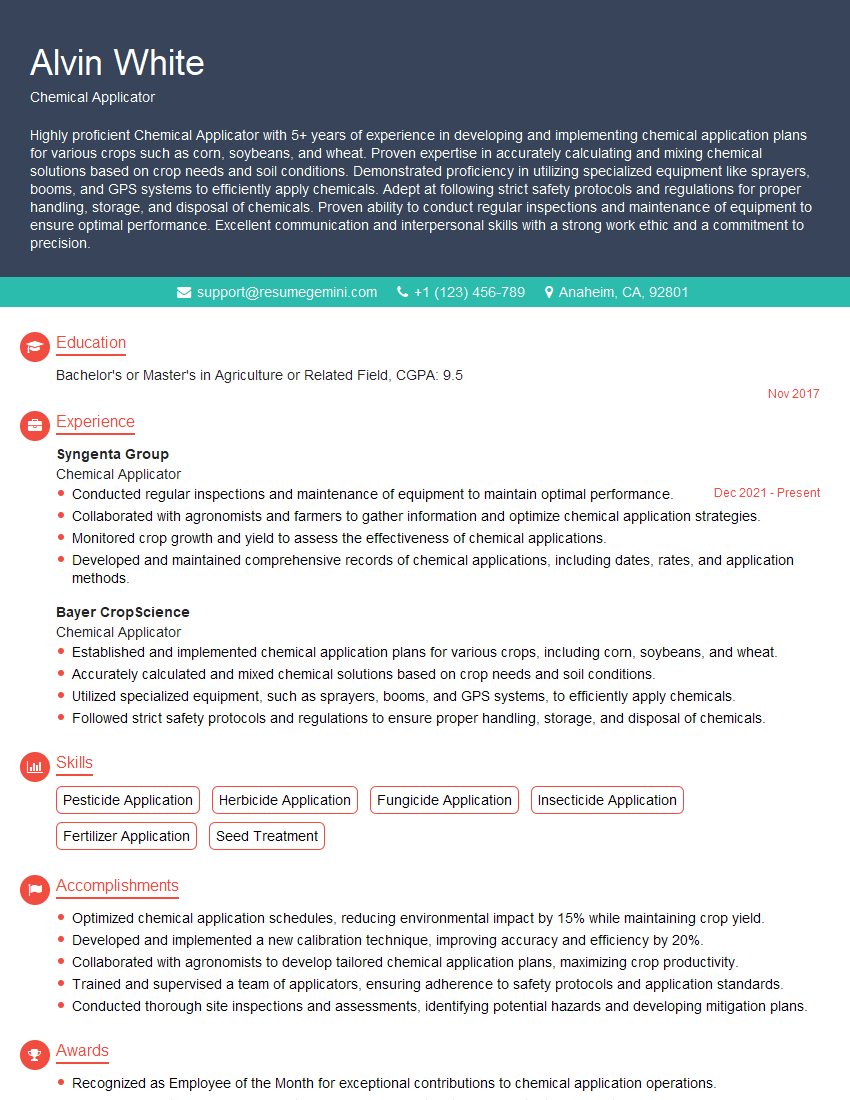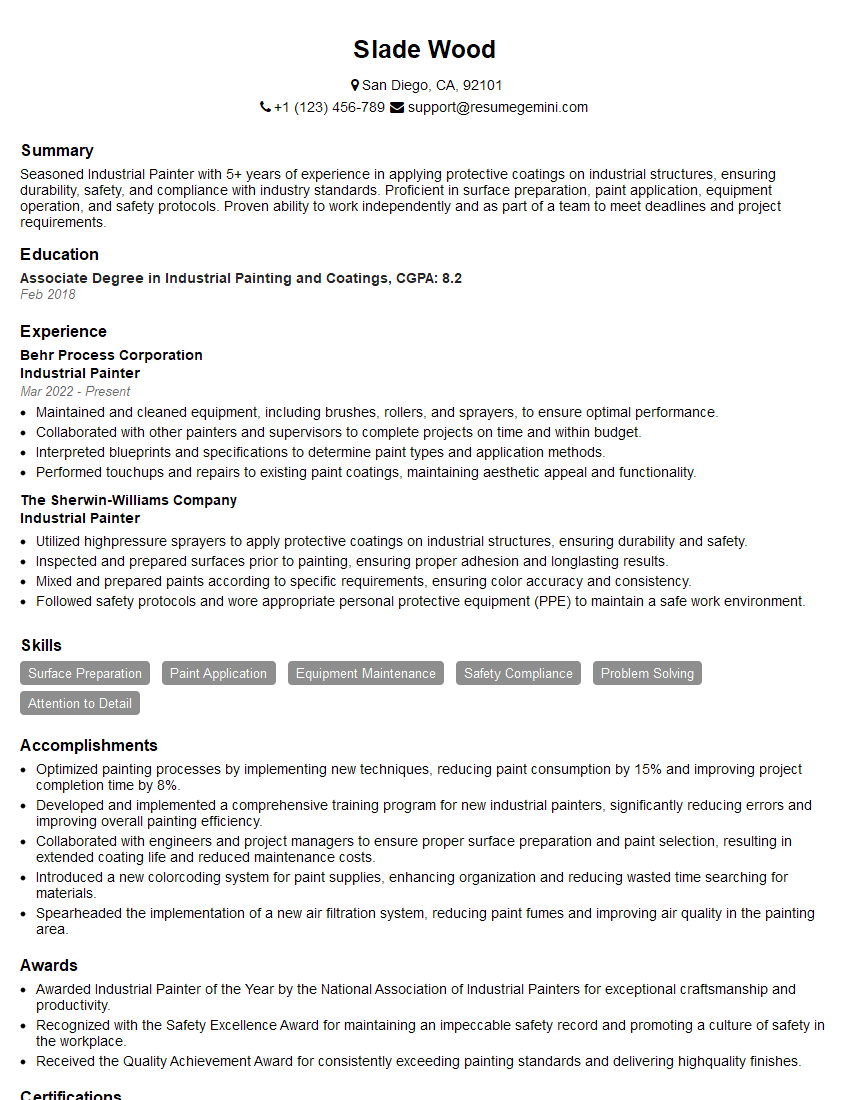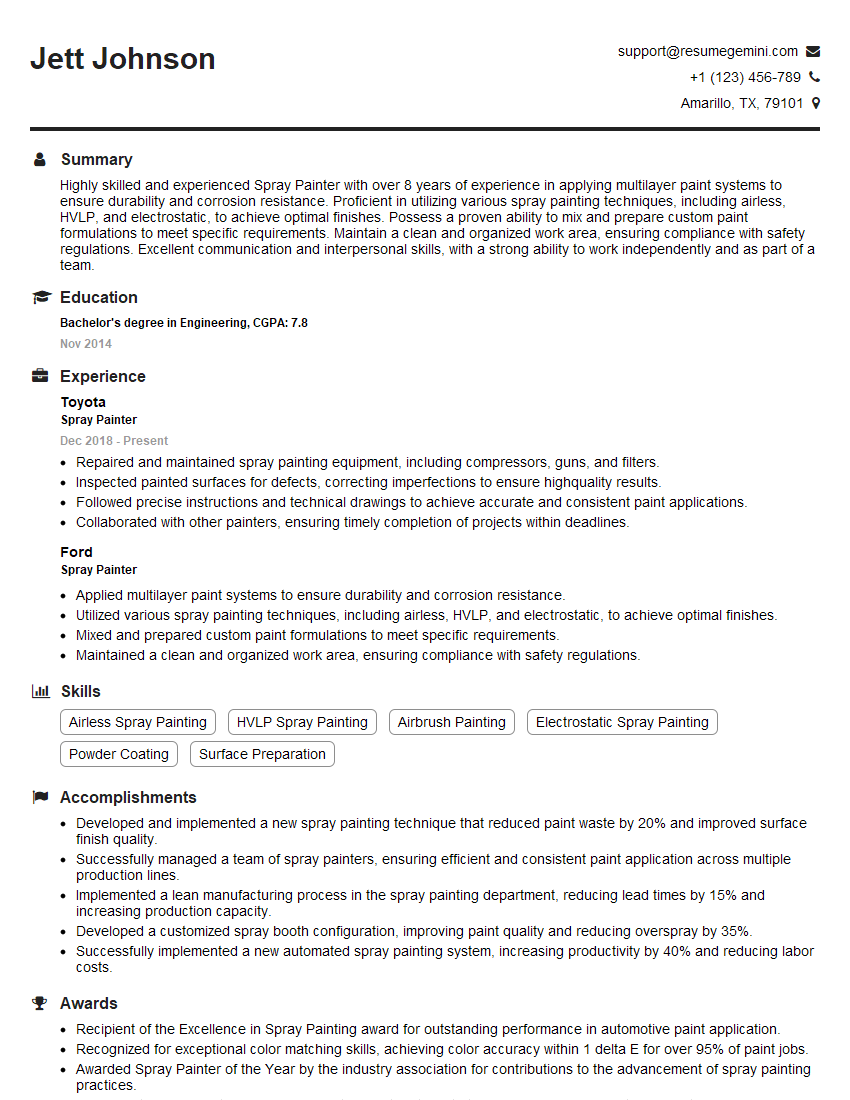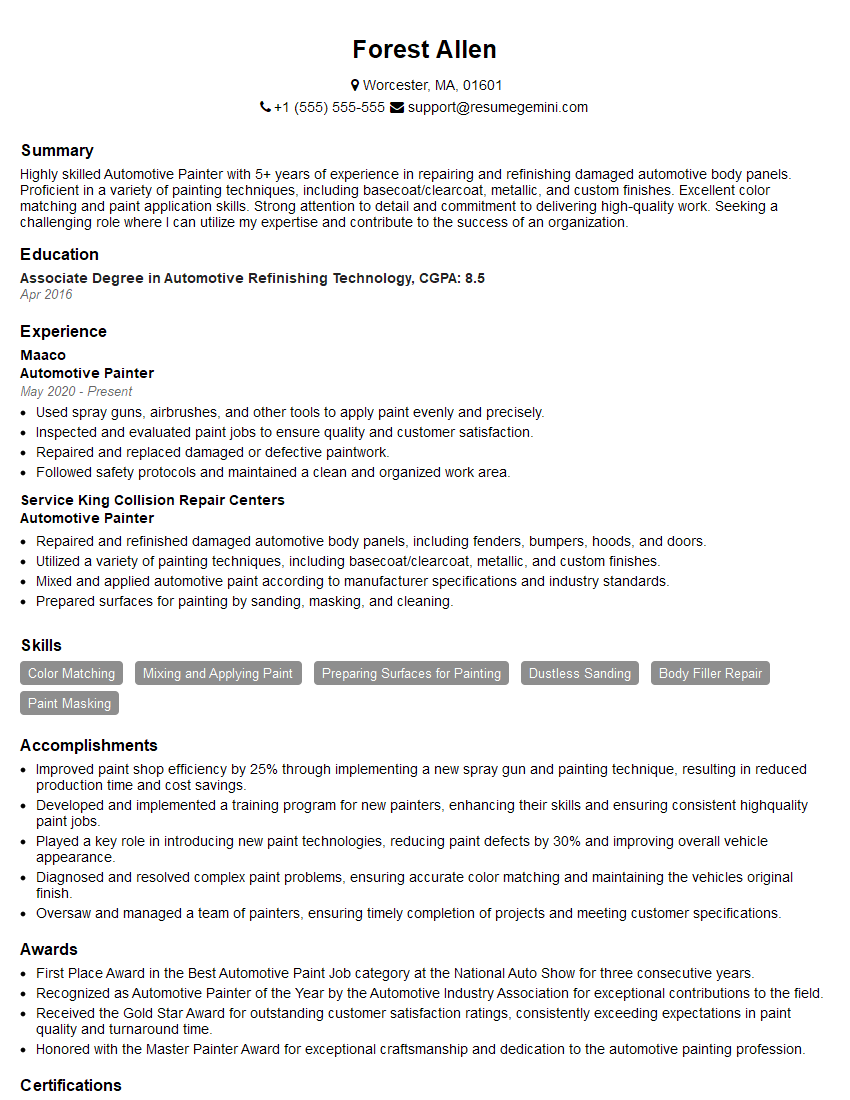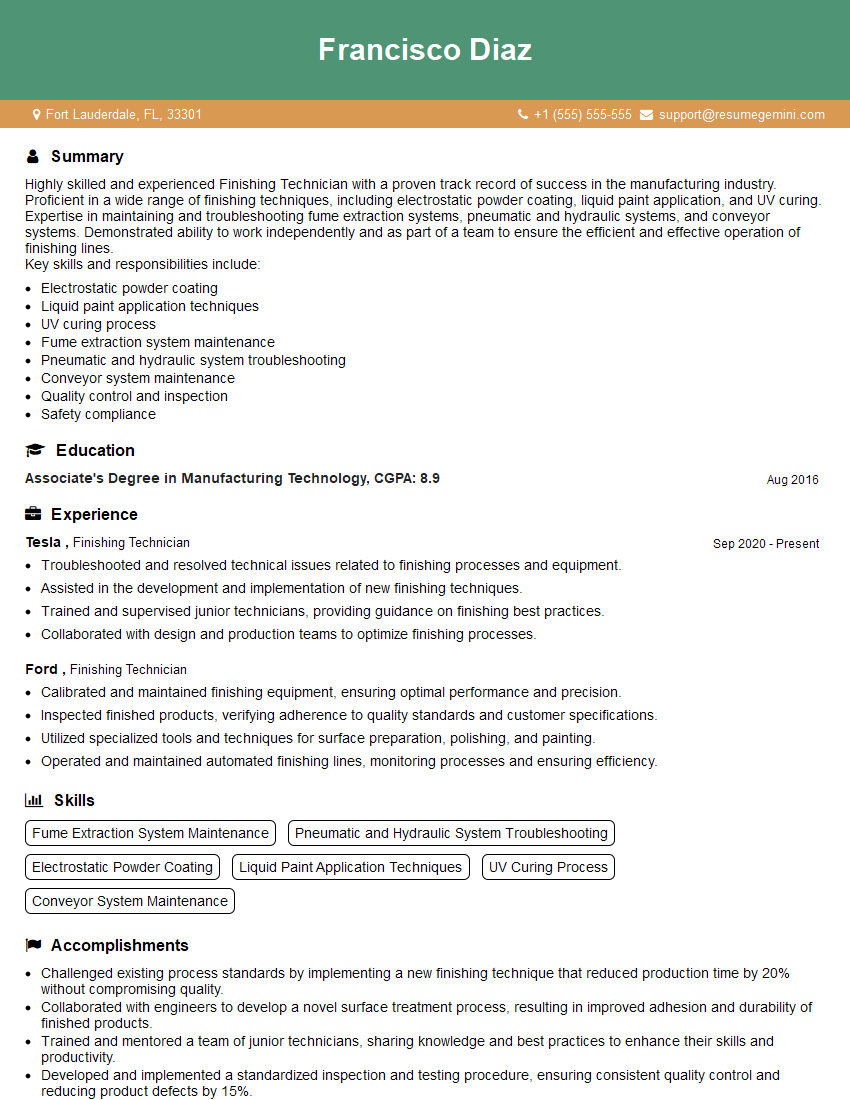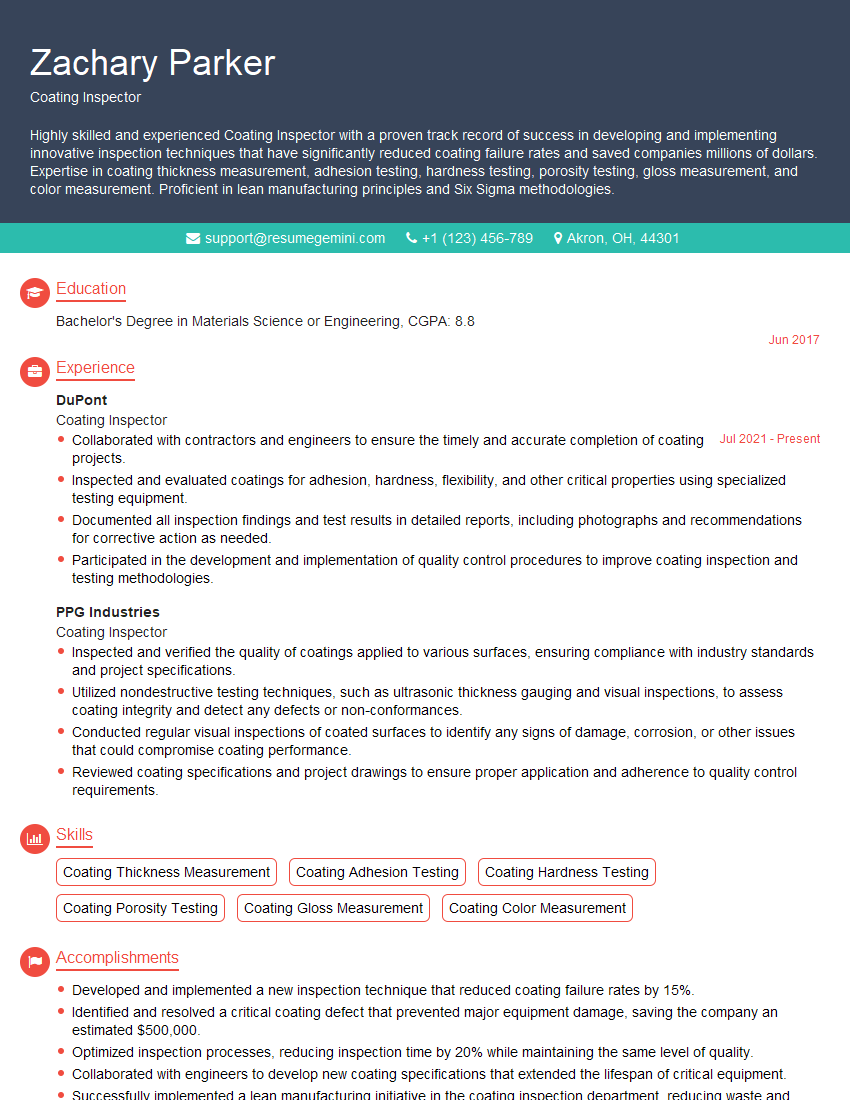Interviews are opportunities to demonstrate your expertise, and this guide is here to help you shine. Explore the essential Chemical Application and Brushing interview questions that employers frequently ask, paired with strategies for crafting responses that set you apart from the competition.
Questions Asked in Chemical Application and Brushing Interview
Q 1. Explain the different types of brushes used in chemical application and their respective applications.
Brush selection is crucial for successful chemical application. The ideal brush depends heavily on the chemical’s viscosity, the surface being coated, and the desired finish. Here are some common types:
- Natural Bristle Brushes: Made from animal hair (e.g., hog bristle, ox hair), these are excellent for applying oil-based paints and stains due to their ability to hold and release the product evenly. They’re good for smooth surfaces but can be less effective with highly viscous materials.
- Synthetic Bristle Brushes: Made from nylon or polyester, these are versatile and suitable for a wide range of coatings, including water-based paints, lacquers, and varnishes. They’re durable, easy to clean, and resist chemical damage better than natural bristles. Nylon brushes are often preferred for their stiffness, while polyester brushes provide a softer touch.
- Foam Brushes: Disposable foam brushes are ideal for small projects or applications where precise control isn’t critical. They’re lightweight and inexpensive, making them suitable for thin coatings like primers or sealants. However, they are less durable and may shed.
- Roller Brushes: These aren’t technically brushes in the traditional sense, but they are excellent for large surface areas requiring a uniform, even coat. They come in various sizes and materials and are often used with paints and coatings.
For example, a natural bristle brush would be perfect for staining a wooden deck, while a synthetic bristle brush is better for applying an epoxy coating to a concrete floor. A foam brush might be used for applying a thin coat of primer to a small model before painting.
Q 2. Describe the proper techniques for brush cleaning and maintenance.
Proper brush cleaning and maintenance are vital to extend their lifespan and ensure consistent application quality. Neglecting this can lead to clogged bristles, uneven coatings, and ultimately, ruined brushes. Here’s a step-by-step process:
- Immediate Cleaning: As soon as you finish using the brush, immediately clean it with the appropriate solvent (water for water-based paints, mineral spirits for oil-based paints, etc.). The faster you clean it, the easier it will be.
- Solvent Cleaning: Use the recommended solvent and gently work it into the bristles using your fingers or a brush cleaning comb. Swish the brush back and forth in the solvent until no more paint comes out.
- Rinse Thoroughly: Rinse the brush thoroughly with clean solvent to remove any lingering traces of the coating.
- Reshape and Dry: Reshape the bristles, and let it air dry completely away from direct sunlight or heat. Consider storing the brush in a protective sleeve or case.
- Deep Cleaning (Periodically): For deeper cleaning, you may need to use a brush cleaner specifically formulated for the type of bristles. This can remove stubborn paint build-up.
Remember to always check the product’s safety data sheet (SDS) for proper solvent recommendations. For example, using the wrong solvent can damage natural bristle brushes, making them brittle and unusable.
Q 3. What safety precautions must be observed when handling chemicals and applying them with brushes?
Safety is paramount when handling chemicals and brushes. The following precautions must always be observed:
- Personal Protective Equipment (PPE): Always wear appropriate PPE, including safety glasses, gloves (choosing the correct type based on the chemical), a respirator if necessary (depending on the chemical’s volatility and potential toxicity), and appropriate clothing.
- Ventilation: Ensure adequate ventilation to prevent the buildup of harmful fumes. Work in a well-ventilated area or use respirators.
- SDS Review: Carefully read and understand the Safety Data Sheet (SDS) for all chemicals before handling. The SDS provides crucial information about hazards, safe handling procedures, and emergency response.
- Proper Storage: Store chemicals and brushes in a designated, secure area away from ignition sources and incompatible materials.
- Spill Response: Have a spill response plan in place. Know how to handle spills safely and effectively using appropriate absorbent materials.
- Fire Safety: Be aware of fire hazards associated with the chemicals and have appropriate fire extinguishers on hand. Some coatings are flammable.
Failing to adhere to these safety procedures can lead to serious health problems, fire hazards, and environmental damage.
Q 4. How do you ensure uniform coating thickness and prevent runs or sags during brushing?
Achieving uniform coating thickness and preventing runs and sags requires technique and attention to detail:
- Proper Brush Loading: Don’t overload the brush. Load only enough chemical to cover a small area at a time. Too much material can cause runs and sags.
- Consistent Strokes: Use smooth, even strokes, overlapping each previous stroke by about 50%. Avoid dabbing or applying pressure unevenly. The brush should glide across the surface.
- Wet-on-Wet Technique: For large areas, maintaining a wet edge is crucial to prevent lap marks. Apply the chemical in sections, keeping the edge wet as you move to the next section.
- Brush Angle: Maintain a consistent angle of the brush. Experiment to find the angle that yields the smoothest and most even application.
- Multiple Thin Coats: Apply multiple thin coats rather than one thick coat. This helps reduce the risk of runs and sags and provides a more durable finish. Allow each coat to dry completely before applying the next.
Imagine painting a wall – if you apply too much paint at once, it will run. The same principle applies to any chemical application using a brush.
Q 5. Explain the importance of surface preparation before chemical application.
Surface preparation is the foundation of a successful chemical application. A poorly prepared surface will lead to poor adhesion, premature failure of the coating, and an overall unsatisfactory finish. Here’s why it’s important:
- Improved Adhesion: Proper preparation ensures the chemical coating adheres properly to the surface, preventing peeling, cracking, or blistering.
- Enhanced Durability: A clean, prepared surface ensures the coating lasts longer and provides the intended level of protection.
- Uniform Finish: A smooth, even surface produces a better-looking and more consistent finish.
- Reduced Consumption: A well-prepared surface requires less material to achieve the same level of coverage.
Preparation steps may include cleaning, sanding, etching, or priming depending on the substrate and coating. For instance, before painting a rusty metal surface, you need to remove rust and apply a rust-inhibiting primer to ensure the paint adheres properly and prevents further corrosion.
Q 6. What are the different types of chemical coatings and their suitable applications?
Various chemical coatings are available for diverse applications. The choice depends on the desired properties and the substrate being coated:
- Paints (Oil-based, Water-based, Epoxy): Provide aesthetic appeal, protection from the elements, and sometimes specific functional properties (e.g., anti-corrosion). Oil-based paints are durable but slow-drying, while water-based paints are easier to clean up. Epoxy paints offer exceptional hardness and chemical resistance.
- Varnishes: Transparent coatings that protect and enhance the natural beauty of wood and other surfaces. They provide a protective layer against moisture and scratches.
- Lacquers: Fast-drying coatings that provide a hard, durable finish. They are often used for furniture and other fine finishes.
- Sealants: Prevent moisture penetration and protect against damage. They’re commonly used in construction and waterproofing.
- Primers: Improve adhesion of subsequent coatings and can provide corrosion protection or specific functional properties.
For example, an epoxy coating would be suitable for a chemical storage tank due to its excellent chemical resistance, while a water-based paint would be appropriate for interior walls.
Q 7. How do you determine the appropriate amount of chemical to apply for a given surface area?
Determining the appropriate amount of chemical depends on several factors:
- Surface Area: Measure the surface area to be coated accurately. Use measuring tapes, calculators, and potentially software for complex shapes.
- Coating Thickness: The manufacturer’s recommendations for the desired coating thickness (typically given in mils or microns) must be considered.
- Material Coverage Rate: Check the manufacturer’s specifications for the chemical’s coverage rate (usually expressed as square feet or square meters per gallon or liter). This varies by product.
- Number of Coats: Account for the number of coats required to achieve the desired finish. Multiple coats may be needed for complete coverage and optimal performance.
A simple calculation: Total Chemical Needed = (Surface Area * Coating Thickness) / Coverage Rate However, it is essential to add a safety factor (usually 10-15%) to account for losses during application and any unforeseen circumstances.
Q 8. What are the common problems encountered during chemical application and how are they resolved?
Common problems during chemical application often stem from inadequate surface preparation, incorrect application technique, or unsuitable environmental conditions. For instance, uneven surface application can lead to weak adhesion and premature coating failure. Poor mixing of the chemical can result in inconsistent film thickness and compromised performance. Application in high humidity or low temperatures might cause slow curing or even prevent proper adhesion.
- Problem: Uneven surface application. Solution: Thorough surface preparation, including cleaning, priming, and sanding, is crucial. Using the appropriate application tools (rollers, brushes, sprayers) and maintaining consistent application pressure helps achieve uniformity. Pre-wetting the surface can also help with even application of some materials.
- Problem: Incorrect mixing ratios. Solution: Always follow the manufacturer’s instructions meticulously. Use calibrated measuring tools to ensure accurate mixing proportions. Thorough mixing using a suitable stirrer is essential for consistent results.
- Problem: Environmental factors affecting curing. Solution: Control the temperature and humidity during application and curing. This may require using heaters, dehumidifiers, or choosing application windows with suitable weather conditions. Some coatings require specific temperature ranges for proper curing; pay close attention to the product data sheet.
Q 9. Describe your experience with different types of application equipment (e.g., rollers, sprayers).
My experience encompasses a wide range of application equipment. I’m proficient with airless sprayers for large-scale projects requiring even and rapid coverage, especially for coatings like epoxy primers. Airless sprayers provide a very efficient means for covering large areas and reduce the risk of brush marks. For smaller areas or projects requiring a more detailed finish, I’m skilled in using various brush sizes and types, selecting the appropriate bristle material (natural or synthetic) based on the coating’s viscosity and surface texture. Rollers are excellent for large, flat surfaces, ensuring a smooth and even finish, particularly useful for applying topcoats over primed surfaces. My experience also includes the use of specialized equipment like electrostatic sprayers for achieving precise coating application on complex shapes and hard-to-reach areas. I’ve also used specialized brush and roller systems for unique application needs.
Q 10. How do you handle different surface textures during chemical application?
Handling different surface textures requires adjusting application techniques and potentially selecting different equipment. Rough surfaces absorb more material, requiring a heavier application to achieve the desired thickness. For porous surfaces like concrete, multiple coats may be needed. For smooth surfaces, such as polished metal, achieving an even, thin film is more critical to avoid runs or sagging. I tailor my approach to each surface using techniques like back-rolling (using a roller to level out brush marks) or employing specific roller nap lengths to match the surface texture, and pre-wetting surfaces to reduce material absorption.
- Example: Applying a coating to a textured brick wall would involve using a thicker nap roller to ensure adequate coverage in the crevices. On the other hand, applying to a smooth, glossy surface would necessitate using a short-nap roller and ensuring even pressure to prevent blemishes.
Q 11. Explain the concept of viscosity and its impact on chemical application.
Viscosity refers to a fluid’s resistance to flow. In chemical application, it’s crucial because it directly impacts the ease of application and the final coating’s appearance. High viscosity coatings are thicker and flow less readily, requiring more effort during application and potentially leading to brush marks or unevenness. Low viscosity coatings are thinner, flow more easily, but might result in runs or sagging on vertical surfaces. The ideal viscosity depends on the coating type, application method, and surface texture. Adjustments can be made by using thinners or adding specific rheological modifiers which are designed to change a coating’s viscosity, as always guided by manufacturer specifications.
- Example: A high-viscosity epoxy coating might need to be thinned slightly before application with a brush, to help aid with the brushing and application process. A low-viscosity coating, on the other hand, might require a slower and more controlled application method to prevent runs.
Q 12. How do you ensure proper ventilation and safety during the application process?
Ensuring proper ventilation and safety is paramount during chemical application. Many coatings release volatile organic compounds (VOCs) which can be harmful if inhaled. Adequate ventilation, often through mechanical exhaust systems or open windows, is essential to dilute these VOCs to safe levels. Appropriate personal protective equipment (PPE) is also critical, including respirators, gloves, eye protection, and coveralls. It is necessary to follow the specific safety data sheets (SDS) provided by the coating manufacturer for detailed handling instructions and safety precautions. These sheets provide important information on the hazards, first aid procedures, and storage requirements of each coating.
- Example: When working with a solvent-based coating in a confined space, a respirator with organic vapor cartridges is mandatory. Proper signage warning personnel of potential hazards would be in place, ensuring a safe working environment for everyone.
Q 13. Describe your experience with different types of chemical coatings (e.g., epoxy, polyurethane).
I have extensive experience with various chemical coatings, including epoxies, polyurethanes, and acrylics. Epoxies are known for their exceptional durability and chemical resistance, making them suitable for heavy-duty applications like flooring and tank linings. Polyurethanes offer excellent flexibility and abrasion resistance, commonly used in protective coatings for machinery and automotive applications. Acrylics provide good UV resistance and are often used in decorative finishes. My experience includes working with different types of each coating, such as solvent-based and water-based options, each with unique characteristics and application methods. Understanding these differences allows me to select the appropriate coating for the specific requirements of the job and to apply it effectively. The choice of coating will also be informed by factors such as budget, aesthetic requirements, and the substrate to be coated.
Q 14. What are the environmental considerations when working with chemical coatings?
Environmental considerations are paramount in the chemical coating industry. VOC emissions from coatings contribute to air pollution and impact air quality. We must follow regulations to minimize these emissions by using low-VOC or VOC-free coatings whenever possible. Proper disposal of waste coatings and solvents is also crucial to prevent environmental contamination. Selecting coatings with sustainable ingredients and minimizing overspray through efficient application techniques reduces environmental impact. It is essential to understand and adhere to all relevant environmental regulations and best practices. We always strive to minimize waste and use environmentally friendly products and processes.
Q 15. How do you ensure that the applied chemical coating meets quality standards?
Ensuring a chemical coating meets quality standards involves a multi-step process starting even before the application. It begins with selecting the right coating for the substrate and intended use, considering factors like chemical resistance, durability, and aesthetic requirements. Then, meticulous surface preparation is critical – proper cleaning, sanding, and priming are all essential to ensure optimal adhesion. During application, consistent brush strokes, correct coating thickness, and proper environmental conditions (temperature and humidity) are monitored.
Post-application, we employ various quality control checks. This might involve visual inspection for imperfections like runs, sags, or pinholes. We may also use instruments to measure the coating’s thickness, ensuring it falls within the specified range. Adhesion tests might be carried out, and depending on the specific chemical, further testing like gloss, hardness, or chemical resistance might be performed to validate the coating’s performance against the defined standards. Any deviations from the standards trigger corrective actions, potentially including re-coating or investigating the root cause of the problem.
For example, in a recent project involving coating steel pipes for a chemical plant, we used a calibrated wet film thickness gauge to ensure the epoxy coating’s thickness met the required 100-150 microns, and performed adhesion testing by cross-cutting the coating according to ASTM standards. Detailed records of each step, including materials used, application techniques, and test results, were meticulously documented to maintain traceability.
Career Expert Tips:
- Ace those interviews! Prepare effectively by reviewing the Top 50 Most Common Interview Questions on ResumeGemini.
- Navigate your job search with confidence! Explore a wide range of Career Tips on ResumeGemini. Learn about common challenges and recommendations to overcome them.
- Craft the perfect resume! Master the Art of Resume Writing with ResumeGemini’s guide. Showcase your unique qualifications and achievements effectively.
- Don’t miss out on holiday savings! Build your dream resume with ResumeGemini’s ATS optimized templates.
Q 16. How do you troubleshoot common problems such as uneven coating, bubbling, or cracking?
Troubleshooting coating issues requires a systematic approach. Uneven coating often points to inconsistent application technique, improper mixing of the chemical, or insufficient surface preparation. Bubbling frequently indicates trapped air or moisture under the coating, or a chemical reaction between the coating and the substrate. Cracking may result from stress on the coating due to rapid drying, poor flexibility of the coating, or substrate movement.
Our troubleshooting process typically starts with a thorough visual inspection to identify the pattern and location of the defects. This is followed by reviewing the application process and checking for any deviations from the established procedure. For uneven coating, we might adjust the application technique or brush type. For bubbling, we focus on eliminating trapped air or moisture, and might adjust drying times or substrate preparation. Cracking problems often require a more detailed analysis, possibly including testing the coating’s flexibility or evaluating the substrate’s movement. Sometimes, a completely new application is necessary to correct the issue.
For instance, if we encounter bubbling in a paint application, we first investigate if the surface was properly cleaned and if all moisture was removed. We then check the paint’s mixing ratio, and finally we assess the drying conditions. If all seem correct, we might adjust the number of thinner coats to allow better drying in between coats, and adjust the drying environment.
Q 17. What is your experience with different types of brush strokes and their application?
My experience encompasses various brush strokes, each suited to different applications and desired finishes. The most common are: The lay-off stroke, which is long, even strokes designed for a smooth, even coat; the tipping-off stroke, short, light strokes used to smooth out the previous lay-off stroke and eliminate brush marks; and the feathering stroke, a series of overlapping strokes used to blend edges and achieve a seamless finish.
Different brush types also dictate the appropriate stroke. For example, a wide, flat brush is ideal for large, even surfaces, while a smaller brush is better for detailed work or corners. The angle of the brush relative to the surface also affects the outcome – a more vertical angle might create a heavier coat, while a shallower angle might result in a thinner, more even layer. The viscosity of the coating influences the stroke’s effectiveness as well – a thicker coating might require more pressure and slower strokes.
In one project, painting a delicate antique furniture piece required using a fine sable brush with feathering strokes to achieve a flawless finish. Conversely, painting a large fence used a wide brush with long, even lay-off strokes. Masterfully combining the brush type and stroke technique helps to deliver the best quality coating finish
Q 18. Describe your experience with different types of solvents and their impact on chemical application.
Solvents play a crucial role in chemical application, influencing the coating’s viscosity, drying time, and even its long-term performance. They are used to thin coatings, allowing for easier application and better penetration into porous surfaces. The choice of solvent depends heavily on the coating itself and the desired properties. Different solvents have different boiling points and evaporation rates, affecting the drying time and the final film properties. Some solvents might also affect the coating’s chemical resistance and durability.
For instance, mineral spirits are commonly used as solvents for oil-based paints, while water is the solvent for water-based acrylic paints. Using the wrong solvent can result in poor adhesion, bubbling, or an uneven finish. Understanding the compatibility of solvents with different coatings is vital for achieving optimal results. Additionally, safety precautions are critical when working with solvents, as many are flammable and potentially harmful. Proper ventilation is essential, and personal protective equipment (PPE) like gloves and respirators should always be used.
In a recent project involving a specialized acrylic coating, we used a specific blend of solvents, carefully controlled to maintain the coating’s viscosity within a tight range and optimize the drying time, ensuring we met the necessary specifications and safety regulations.
Q 19. What are the different types of surface preparation techniques (e.g., sanding, cleaning)?
Surface preparation is arguably the most critical step in chemical application. A poorly prepared surface will lead to poor adhesion, leading to early coating failure. Techniques include: Cleaning: removing dirt, grease, rust, old coatings, or other contaminants using solvents, detergents, abrasive blasting, or high-pressure washing. Sanding: using abrasives of varying grits to smooth the surface, improve its profile for better adhesion, and remove imperfections. Priming: applying a primer coat which improves adhesion, provides a uniform base for the topcoat, and seals porous surfaces. Etching: chemical treatments to enhance adhesion to metals and other substrates.
The choice of technique depends on the substrate and the coating being applied. For example, metal surfaces might require cleaning with a solvent, followed by sanding and priming, whereas a porous wooden surface may benefit from cleaning with a detergent and a wood primer. Proper surface preparation is critical; the cost of correcting poor surface prep is significantly higher than preparing the surface appropriately at the onset.
In one instance, we had to meticulously clean and sand a rusty steel structure before applying a protective coating. Failing to do so adequately would have resulted in premature coating failure due to poor adhesion, requiring costly repairs down the line.
Q 20. How do you determine the appropriate drying time for a specific chemical coating?
Determining the appropriate drying time for a specific chemical coating involves considering several factors. These factors include the coating type (oil-based, water-based, etc.), the film thickness, ambient temperature, humidity, and ventilation. Thicker coatings generally take longer to dry than thinner coatings, while warmer temperatures and lower humidity generally accelerate drying. Adequate ventilation is also crucial to prevent trapped moisture and reduce drying time.
Manufacturers’ data sheets for specific coatings often provide guidelines on drying times under standard conditions. However, these are only estimates. It is important to monitor the drying process and make adjustments based on the actual conditions. Visual inspection, touch testing (carefully!), and sometimes specialized tools for monitoring moisture levels can all help in determining if the coating is adequately dry. Rushing the drying process can lead to problems like cracking, bubbling, and poor adhesion. Insufficient drying can result in an inferior final product or adhesion failure.
For example, a recent project called for an epoxy coating. The manufacturer specified a 24-hour drying time at 20°C and 50% humidity, but due to lower temperatures on site, we allowed an extra 12 hours to ensure complete curing. We monitored the coating’s hardness using a specialized gauge.
Q 21. Explain the importance of maintaining accurate records and documentation.
Maintaining accurate records and documentation is crucial for several reasons. Firstly, it ensures traceability. Detailed records allow us to track the materials used, the application process, and the results of any quality control checks. This is vital for ensuring consistency and identifying the causes of any problems. Secondly, it’s essential for regulatory compliance. Many chemical coatings are subject to stringent regulations regarding their application, safety and disposal. Accurate documentation helps prove that all procedures were followed correctly.
Finally, it facilitates problem-solving. If a coating fails or does not perform as expected, detailed records enable efficient troubleshooting by pinpointing the source of the issue. This can be a major cost and time saver in large-scale projects. We generally use documented standard operating procedures (SOPs), and maintain detailed batch records, logging everything from the date and time of application, environmental conditions, materials used, quality control tests, and any deviations from the SOPs.
In our industry, complete and accurate documentation is not just good practice; it is a critical component for quality assurance, legal compliance and project success. Consider a situation where a coating fails and causes significant damage. If we have detailed records of the application process, including the precise type of coating, the surface preparation steps, and even the weather conditions, we can investigate the failure’s root cause, and can easily prove we adhered to safety and environmental regulations.
Q 22. Describe your experience with applying coatings in confined spaces.
Working in confined spaces requires meticulous planning and specialized techniques. My experience includes applying coatings in various confined environments, such as the interiors of tanks, pipelines, and bridges. Safety is paramount. Before starting, we conduct a thorough risk assessment, identifying potential hazards like oxygen deficiency, toxic fumes, and confined space entry issues. This involves using appropriate gas detectors and ensuring proper ventilation. We utilize specialized equipment such as air-fed respirators and confined space entry suits to protect against these hazards. The application technique itself might require modifications; for example, using smaller brushes or spray equipment with extended nozzles for better reach and maneuverability. I always emphasize precise and controlled application to minimize material waste and ensure even coverage, which is especially crucial in tight spaces where access for rework is challenging. One particular project involved coating the interior of a large water storage tank; we implemented a phased approach to minimize disruption and ensure the safety of the team.
Q 23. How do you adapt your techniques to different environmental conditions (e.g., temperature, humidity)?
Environmental conditions significantly affect coating application. Temperature influences the viscosity of the coating material; for instance, lower temperatures can lead to increased viscosity, requiring more effort for application and possibly affecting the final finish. High temperatures, conversely, can cause the coating to dry too quickly, leading to inconsistencies. Humidity can also impact drying time and adhesion. High humidity can slow drying and potentially lead to issues with curing. My approach involves careful pre-planning, referring to the manufacturer’s instructions for the specific coating, which always detail acceptable temperature and humidity ranges. We use appropriate tools and techniques to compensate for environmental factors. For example, on a hot day, we might use a slower application rate or adjust spray parameters to prevent premature drying. Similarly, in high humidity, we’ll extend the drying time and monitor the curing process to ensure complete adhesion. Careful monitoring of environmental conditions throughout the application process is crucial for quality control and safety.
Q 24. Describe your experience with using personal protective equipment (PPE).
Personal Protective Equipment (PPE) is an absolute necessity in chemical application. My experience includes using a wide range of PPE, including respirators (both air-purifying and supplied-air), gloves (chemical-resistant materials selected based on the specific chemicals used), eye protection (safety glasses or goggles, sometimes face shields), protective clothing (coveralls, aprons, boots), and hard hats. The selection of PPE is dictated by the specific hazards associated with the chemicals being used and the task being performed. I am always meticulous about proper PPE fit and ensure every team member understands how to correctly use and maintain the equipment. Regular inspections are carried out to identify any damage or deterioration. I strongly believe that proper PPE usage is not just a safety requirement but a crucial part of our professionalism and respect for personal well-being. Training is paramount, so we regularly conduct refreshers on PPE use and hazard recognition.
Q 25. How do you manage waste materials generated during the chemical application process?
Waste management is a critical aspect of responsible chemical application. We adhere strictly to all local and national environmental regulations. This includes segregating waste according to its chemical composition, handling leftover coatings appropriately (many have specific disposal requirements), and cleaning up spills immediately using appropriate absorbent materials. Our waste disposal procedures involve using labeled containers, maintaining detailed records of waste quantities and types, and engaging licensed waste disposal companies for safe and compliant removal. We emphasize minimizing waste generation through precise application techniques and careful planning. For example, we carefully measure the quantity of coating needed for a specific project to avoid excess. Clean-up procedures are detailed and practiced regularly, to minimize environmental impact and ensure worker safety. Documentation is thorough and transparent to maintain full traceability.
Q 26. What is your understanding of the health hazards associated with chemical handling?
Understanding the health hazards associated with chemical handling is foundational to my practice. This knowledge includes familiarity with Safety Data Sheets (SDS) for every chemical used. SDS provide comprehensive information on potential health effects, handling precautions, and emergency procedures. I am trained in recognizing symptoms of exposure to hazardous chemicals, such as skin irritation, respiratory problems, or eye damage. I am proficient in administering first aid in case of exposure and know when and how to contact emergency services. Understanding the potential long-term health effects of exposure, such as carcinogenicity or reproductive toxicity, is crucial, and this knowledge influences our choice of materials and methods to minimize risk. Regular health and safety training is essential and ensures that we stay up-to-date on the latest guidelines and best practices.
Q 27. Explain your experience with working in a team setting during chemical application projects.
Teamwork is essential for successful chemical application projects. My experience involves collaborating with various team members, including supervisors, assistants, and other specialists. Effective teamwork includes clear communication, well-defined roles, and mutual respect. Before commencing any project, we hold detailed briefings to outline tasks, safety procedures, and expected outcomes. During the application process, constant communication ensures smooth coordination and problem-solving. I encourage open dialogue and actively participate in resolving any challenges that arise. One example involves a project where a team member experienced a minor chemical spill. Quick, coordinated action, thanks to established safety protocols and team communication, ensured the spill was contained rapidly and without incident. Post-project debriefings are also crucial for identifying areas for improvement and strengthening our teamwork.
Q 28. How do you stay updated on the latest advancements and regulations in the field of chemical application?
Staying current in chemical application requires ongoing professional development. I regularly attend industry conferences, workshops, and webinars to learn about the latest technologies, techniques, and regulations. I also actively participate in professional organizations and read relevant industry publications and journals. Staying informed about changes in regulations is especially important, as they often affect the types of coatings we can use, the application methods we can employ, and the waste disposal procedures we must follow. Following regulatory bodies and actively seeking updates on SDS for all chemicals is a vital part of my ongoing professional commitment. Continuous learning ensures that my practices remain safe, efficient, and compliant with the latest industry standards.
Key Topics to Learn for Chemical Application and Brushing Interview
- Chemical Properties and Selection: Understanding the properties of various chemicals used in application and brushing processes (e.g., viscosity, reactivity, compatibility with substrates). This includes knowing how to select the appropriate chemical for a given application based on its properties and the desired outcome.
- Application Techniques: Mastering various application methods, including brushing, spraying, dipping, and roller coating. This involves understanding the impact of each technique on the final finish and the factors that influence the choice of technique (e.g., surface area, desired thickness, material properties).
- Safety Procedures and Regulations: Thorough knowledge of relevant safety regulations and handling procedures for chemicals used. This encompasses personal protective equipment (PPE), waste disposal, and emergency response protocols.
- Surface Preparation: Understanding the critical role of proper surface preparation before chemical application. This includes cleaning, degreasing, and pre-treatments to ensure optimal adhesion and finish quality.
- Quality Control and Inspection: Methods for inspecting the quality of the applied coating, including visual inspection, thickness measurements, and testing for adhesion and durability. This involves understanding industry standards and quality control procedures.
- Troubleshooting and Problem Solving: Identifying and resolving common problems encountered during chemical application and brushing, such as uneven coating, poor adhesion, and chemical reactions. This requires a systematic approach to diagnosis and problem-solving.
- Equipment and Tool Maintenance: Proper maintenance and care of application equipment, including brushes, spray guns, and other tools. Understanding preventative maintenance and troubleshooting common equipment issues.
Next Steps
Mastering Chemical Application and Brushing techniques is crucial for career advancement in many industries. A strong understanding of these principles significantly enhances your problem-solving capabilities and allows for efficient and high-quality work. To maximize your job prospects, focus on crafting an ATS-friendly resume that highlights your skills and experience effectively. ResumeGemini is a trusted resource to help you build a professional and impactful resume. We provide examples of resumes tailored to Chemical Application and Brushing to guide you through the process. Let ResumeGemini help you showcase your expertise and land your dream job.
Explore more articles
Users Rating of Our Blogs
Share Your Experience
We value your feedback! Please rate our content and share your thoughts (optional).
What Readers Say About Our Blog
Hi, I represent an SEO company that specialises in getting you AI citations and higher rankings on Google. I’d like to offer you a 100% free SEO audit for your website. Would you be interested?
good
